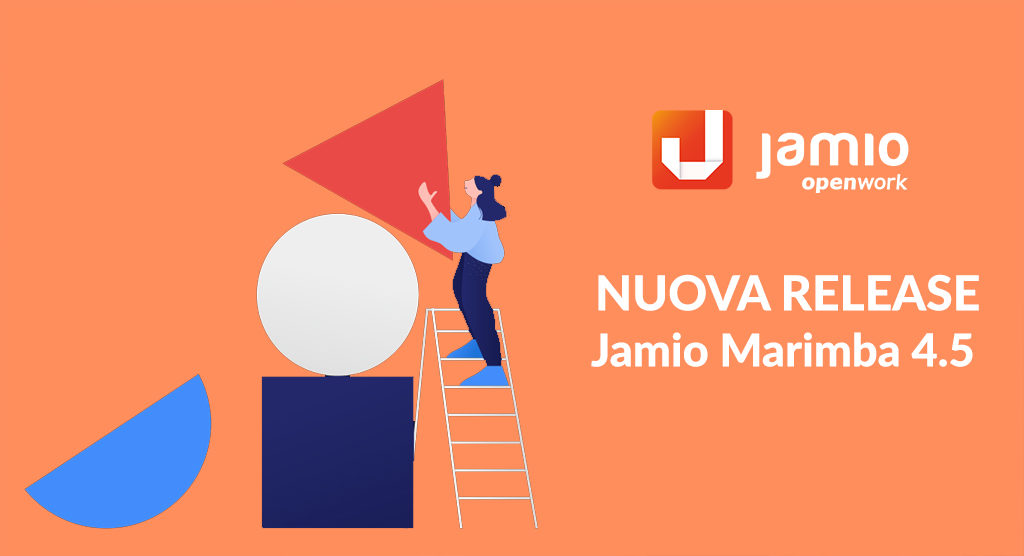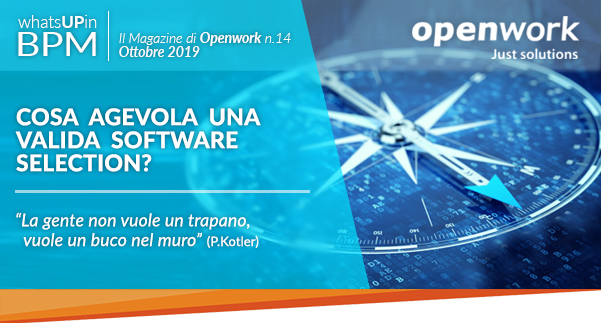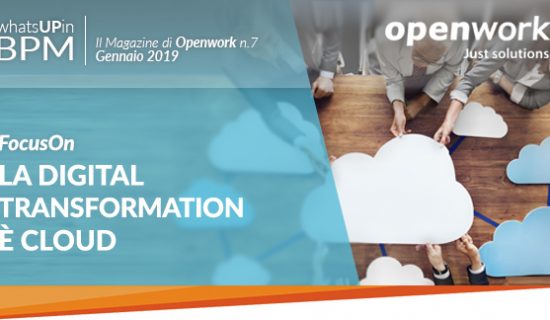What facilitates a valid software selection
A product has value based on its ability to help solve the buyer's problems. This universal maxim holds true in B2C, for consumer products, but even more so when it comes to one of the most long-suffering business choices: the purchase of software.
The need that drives the search for new software usually drives the IT Manager or whoever is in charge of scouting, to look for a ready-made, pre-packaged, modular application. And already here the landscape is wide and confusing. One looks for the drill that has roughly the right bits to drill a hole similar to the business needs.
If for vertical needs, related to a specific business function (administration, sales, logistics, etc.), now "codified," it is easier to rely on a commercial software, with generalist features that can be exploited in different contexts, for the management of organizational processes or cross-cutting operations it is not comfortable to adapt to an off-the-shelf product.
From off-the shelf to custom
There is a need, in cases such as these, to shift scouting from ready-to-go to custom software, which involves design, development, and release tailored to the needs of an individual entity. The use of a "finished" product is a possibility to be ruled out precisely because of the characteristics of the hole to be drilled, because compromising with the functionality of the off-the-shelf software means adapting "one's business" to the application; it would be like forcing an organization, by compressing it, through a hole that is too narrow.
Business Requirements = Solution Features?
Customization first requires translating specific organizational requirements into IT features, moving from business to technical language: as in any translation, misunderstanding is around the corner, and the business mandate may not match the end result.
With software that does not yet exist, how can it be verified that it does in fact meet the expressed need? If the software is to be implemented, how can the correspondence between the features of the ad hoc produced solution and the requirements expressed in the need description be validated upstream?
Ideally, it is not possible, or rather, it is not possible if we evaluate traditionally developed software, where the code is the master, the development time is long, the results are seen when the application is finished, the changes involve major tampering, and the language is distant from the language of the business. The company that requires the development of a custom solution has an obligation, more economic than moral, to know its requirements perfectly by performing a very thorough analysis, so that the final result is not in vain and even more extremely wasteful.
Zero-code modeling. Why so?
When then is it possible to assess whether a custom application is in fact the best fit, the ad hoc drill for our hole? We find the answer in the technological and methodological innovation of custom IT design: software modeling platforms that use no programming code(zero code). So why should this approach be successful?
Modeling on a zero code platform has some undeniable advantages:
- By not using programming code, it allows upstream verification of the correspondence between business demand and translation into software;
- Implementation time is reduced to a few days for the first core solution;
- The development of the solution is gradual and scalable, thus allowing for course changes, revisions, and expansions on the go;
- Development is sustainable because it is difficult for the end result not to match the initial demand;
- Gradual development on a platform allows me to check as I implement the solution whether the idea I have in mind actually makes sense.
Into the black box: the Try&Buy
However, one unresolved doubt remains, even if we opt for "accelerators" such as Zero code platforms to build "the software we want," we will always first have to rely on checklists, evaluation grids, etc., before buying "the drill" best suited to us, and then, after using it, fully verifying, certainly more quickly, that the hole is the one we were looking for. It is therefore and always an act of "faith" that often hinders the purchase.
In this landscape, a very effective tool for jumping the hurdle of the closed-box purchase is the Try&Buy, i.e., the possibility for the customer to test, for a limited period, a solution already available on the platform, so as to verify its performance, or even to implement a very simplified version of the desired solution, in order to evaluate its accuracy, speed of development, ease of use and all those variables that are relevant and functional to the purchase.
In addition, a manned Try&Buy formula also makes it possible to evaluate a very relevant aspect of software purchase: the relationship with the technology vendor. As complex as a sale can be, in the time of a product demo or illustration of the solution's features, it is difficult to test even the willingness of the selling company. A manned formula guarantees, in the time frame in which the Try&Buy is developed, to test the vendor's availability, ease of contact, etc.
This formula, in conclusion, allows the customer to resolve his or her doubts and answer the thousands of questions that arise when choosing the best software for business needs, guaranteeing economic and organizational effectiveness and returning value to the product because it is capable of helping to solve the buyer's problems from the purchase stage.
Such a sales and customer care philosophy from the pre-sales stage has been espoused by some international market players, as well as by openwork, which, offers the Try&buy option for its Jamio openwork development platform.
Do you also want to try the Zero-Code Jamio?

Editorial by:
Rita Genchi - Marketing & Sales Specialist
NEW APPROACH TO BUSINESS COMMUNICATIONS AT THE HEART OF JAMIO RELEASE 4

The issue of corporate communications plays a pivotal role in business process optimization. In fact, business issues such as:
- loss of important communications
- failure to assign them
- protection of sensitive data
- failure to monitor the delivery of communications
- mandatory digital storage of PEC communications in accordance with the law
- mass mailings
etc. are almost commonplace.
In this context, technological constraints play an unfavorable role that fuel complexity and business issues, subjecting organizations, and IT managers in particular, to not insignificant legal risks, especially when it comes to PEC/recommendation communications.
Message Hub
It is precisely on this issue that the new Release of Jamio Marimba 4.5 focuses.
Indeed, with the new Message Hub it will be possible to centralize and govern communication processes in an even simpler and more effective way. The multi-recipient and multi-channel approach allows mass mailings to multiple recipients via all means of communication: PEC, email, courier, traditional mail, postage, messaging etc. All available and monitorable on a single solution.
Jamio is Goal Oriented
Indeed, with Jamio it is possible to monitor message transmission and automatically take corrective action if the goal is not achieved correctly and on time. Such as sending a replacement registered letter if a PEC does not reach the sender by a certain date.
JamioPlug Message
Through the new Jamioplug Message it will be easier for designers to configure and manage transmission protocols. The first Plug Message concerns the PEC protocol and will soon be enriched with new transmission channels.
Do you want to know all the details of the new Release?
The new frontiers of IT in Apulia - International Business Forum

The internationally relevant forum "The New Frontiers of IT in Apulia" will be held on Nov. 7 and 8 at the Grand Hotel Masseria Santa Lucia in Ostuni .
The event, promoted by the Apulia Region in collaboration with the Apulian IT Productive District, Puglia Sviluppo and Innovapuglia, aims to explore the evolution of digital technologies with a focus on IT security solutions, a topic on which Apulia plays an important role.
In fact, Puglia, thanks to a cutting-edge information technology sector, is able to offer increasingly innovative IT services, becoming fertile ground for new and challenging research and innovation projects oriented above all to the theme of security.
With this in mind, the Forum intends to enhance Puglia's knowledge and skills useful for network, application and organizational security, and to do so through the use of new emerging technologies such as enabling platforms, artificial intelligence and IoT.
Openwork will also be present at the event bringing its contribution to the topic of cybersecurity and innovative digital technologies.
Participation in the Forum is free after registering at the following link in the NEWS section.
ONE MINUTE TO EXPLAIN HOW IT CAN CHANGE YOUR WORK WITH JAMIO
In an ever-changing market, you need technologies to follow your needs.
Here is Jamio's video.








